The AMD Trinity Review (A10-4600M): A New Hope
by Jarred Walton on May 15, 2012 12:00 AM ESTAMD Trinity Gaming Performance
After the 3DMark results, you might be wondering if Intel has finally caught up to AMD in terms of integrated graphics performance. The answer is…yes and no. Depending on the game, there are times where a fast Ivy Bridge CPU with HD 4000 will actually beat out Trinity; there are also times where Intel’s IGP really struggles to keep pace. The good news is that at least everyone is now onboard the DX11 bandwagon, and compatibility with games has improved yet again for Intel. Here are our “Value” benchmark results for seven recent games; we’ll have more information in a moment.

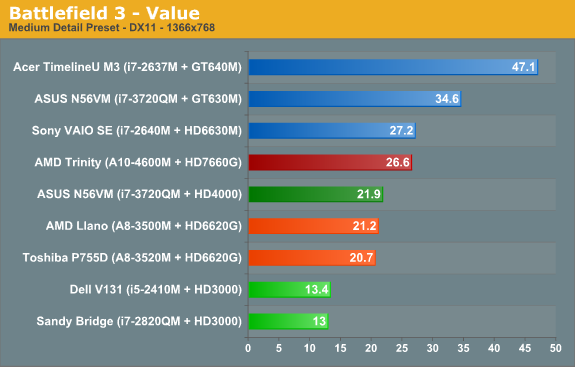
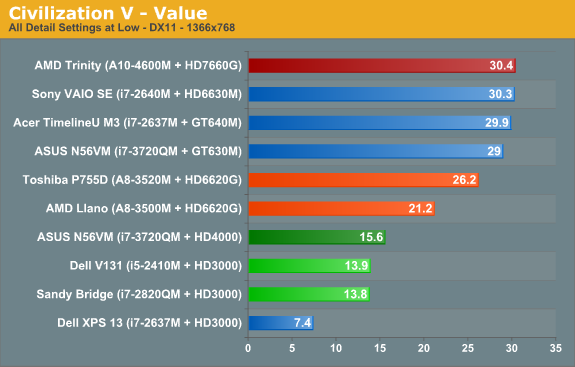

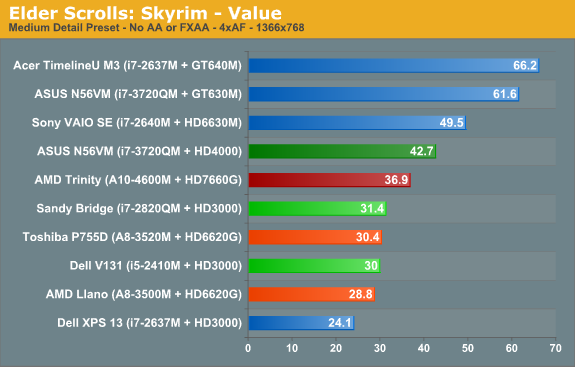
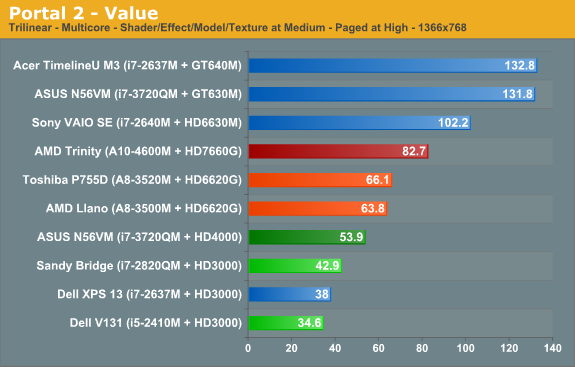
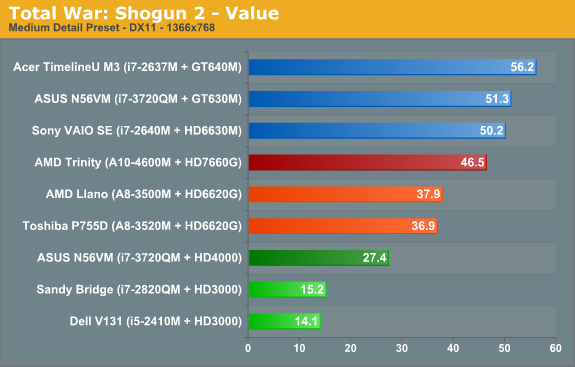
Out of our seven test titles, AMD’s Trinity leads any other IGP in four titles by a large margin. The other three titles actually have Ivy Bridge slightly ahead of Trinity, but the gaps aren’t nearly as big. Overall, the average performance across the seven games at our Value (medium) settings has AMD’s Trinity A10-4600M leading Intel’s i7-3720QM by 21%, and if we look at quad-core Sandy Bridge with HD 3000 (i7-2820QM) Trinity is 72% faster. Trinity is also around 20% faster than 35W Llano on average.
Let’s expand our gaming suite just a bit to see if things change, though. Just like we did with Ivy Bridge, we ran the eight games in our previous benchmark suite at medium detail settings. We can then compare performance across a wider 15 title selection to see how Trinity matches up against HD 4000, HD 3000, and HD 6620G (Llano). We’ll start with the bottom (HD 3000/Sandy Bridge) and move up.
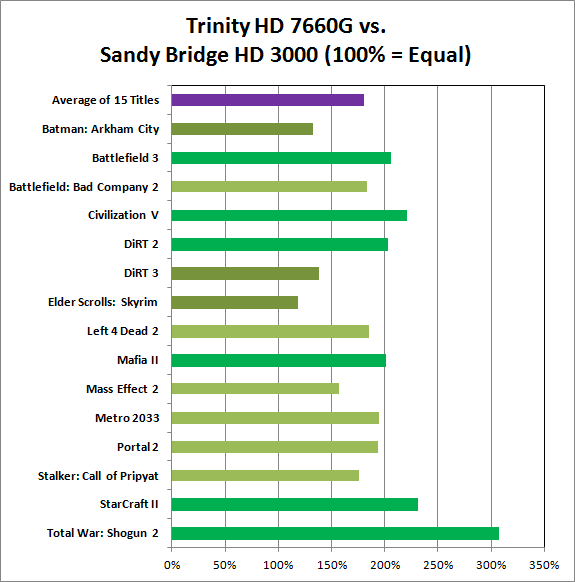
Llano’s HD 6620G was already faster than HD 3000, and Trinity’s HD 7660G is faster than Llano, so the Sandy Bridge gaming matchup is a landslide victory in AMD’s favor. The closest Intel can get is in the same three titles where Ivy Bridge leads Trinity: Batman: Arkham City, DiRT 3, and Skyrim. Here, however, HD 3000 can’t actually close the gap and HD 6620G is at least 20% faster than HD 3000, with an average performance improvement of nearly 80%.
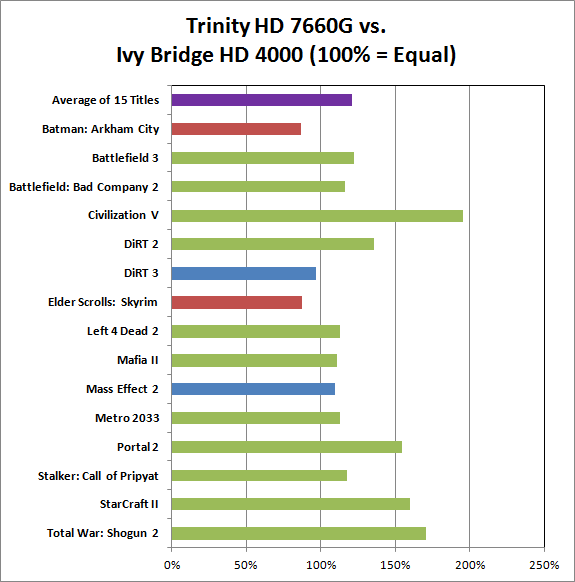
We found that across the same selection of 15 titles, Ivy Bridge and Llano actually ended up “tied”—Intel led in some games, AMD in others, but on average the two IGPs offered similar performance. This chart and the next chart will thus show a similar average increase in performance for Trinity, but the details in specific games are going to be different. Starting with Ivy Bridge and HD 4000, as with our earlier game charts we see there are some titles where Intel leads (Batman and Skyrim), a couple ties (DiRT 3 and Mass Effect 2), and the remainder of the games are faster on Trinity. Mafia II is close to our <10% “tie” range but comes in just above that mark, as do Left 4 Dead 2 and Metro 2033. The biggest gap is Civilization V, where Intel’s various IGPs have never managed good performance; Trinity is nearly twice as fast as Ivy Bridge in that title. Overall, it's a 20% lead for Trinity vs. quad-core Ivy Bridge.
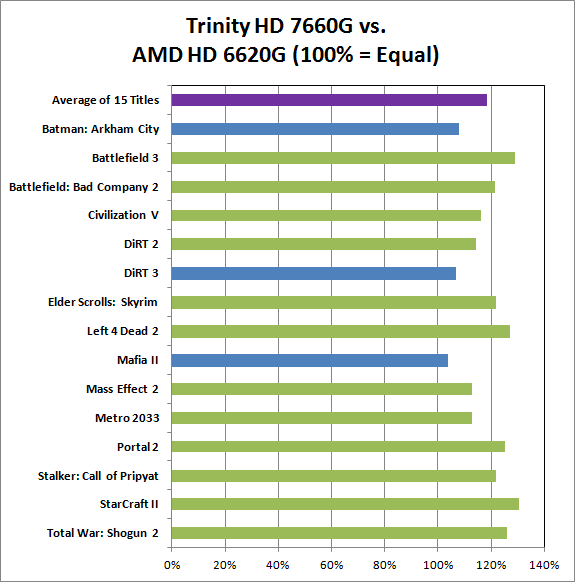
Against Llano, Trinity is universally faster, but the smallest gap is in Mafia II (3%) while the largest gap is in StarCraft II (30%). On average, looking at these games Trinity is only 18% faster than Llano. What’s not entirely clear from the above chart is whether we’re hitting CPU limitations, memory bandwidth limitations (remember that Llano and Trinity share bandwidth with the rest of the system), or perhaps both. At our chosen settings, what is clear is that Trinity’s “up to 56% faster” graphics never make it that high.
We saw 35-45% higher scores in 3DMark 11 and Vantage, which tend to remove the CPU from the equation more than actual games, so our guess would be that if AMD continues with their APU plan they’re going to need to work more on the CPU side of the equation. We also see the same thing looking at the VAIO SE scores in the earlier gaming charts: the HD 6630M scores are 20% faster on average, but much of that appears to come from the faster CPU rather than the GPU.










271 Comments
View All Comments
Taft12 - Tuesday, May 15, 2012 - link
He said "better".http://ir.amd.com/phoenix.zhtml?c=74093&p=irol...
"Linux OS supports manual switching which requires restart of X-Server to switch between graphics solutions."
They ain't there yet!
JarredWalton - Tuesday, May 15, 2012 - link
Enduro sounds like it's just a renamed "AMD Dynamic Switchable Graphics" solution. I haven't had a chance to test it yet, unfortunately, but I can say that the previous solution is still very weak. And you still don't get separate driver updates from AMD and Intel.Spunjji - Wednesday, May 16, 2012 - link
Drivers is the big deal here. I like that I get standard drivers using my Optimus laptop.What I don't like is that it f#@!s up Aero constantly and occasionally performs other bizarre, unpredictable manoeuvres.
ToTTenTranz - Tuesday, May 15, 2012 - link
Greetings,Is it possible to provide some battery life results with gaming?
It's true that an Intel+nVidia Optimus solution should be better for both plugged-in gaming and wireless productivity (more expensive too, but that's been covered in the review).
However, a 35W Trinity should consume quite a bit less power than a 35W Intel CPU + 35W nVidia GPU, so it might be a worthy tradeoff for some.
Furthermore, when are we to expect Hybrid Crossfire results with Trinity+Turks? Is there any laptop OEM with that on the roadmap?
That should give us a better comparison to Ivy Bridge + GK107 solutions, as it would provide better gaming performance at a rather small price premium ($50 the most?).
x264fan - Tuesday, May 15, 2012 - link
thanx for the nice review author, but let me write you some very important information regarding your test.1. x264 HD Benchmark Ver. 4.0 you used is using quite old x264.exe for encoding. It is important for Bulldozer/Piledriver to replace it with the newer once which contain specific assembler optimisation, which gives nice performance boost for AMD processor by using new instructions introduced in those CPUs. You can find how many they are here:
http://git.videolan.org/gitweb.cgi?p=x264.git;a=sh...
I would suggest to download new x264 build from x264.nl and replace it, then run the benchmark again. It would also show you how beneficial new isntructions are.
Another suggestion would be to run this benchmark using x64 build of the x264 throught x86 avisynth wrapper avs4x264mod.exe In this way you can see how much difference x64 uinstructions give.
iN FACT X264 IS SO NICELLY OPTIMISED IT CAN BE USED FOR CPU TESTING.
2. You have used Media Player Classic Home Cinema Edition for measuring playback of h264 streams and battery life. So am I, unfortunatelly every time I want to use it with DXVA acceleration on my i7-2630 laptop I end up with terrible artefacts on smaller bitrate content. Blocks are floating and destroying picture quality. It is not as much visible on Blu-Ray content where the picture is more recommpressed than recreated using x264 transformations, but it is still there. My point is that if the INTEL decoding/drivers are so buggy which makes this dxva mode so unusable, how can anyone would like to measure battery life with this mode?
Without DXVA intel numbers would not be so good, but so far this mode is only usable.
3. I must say i am amased how good hd4000 is, but what about picture quality. From time to time we see the reports that nvidia or amd has cheated in drivers sacrifacing picture quality, so how about intel...
I hope you read my comment and update your test.
JarredWalton - Tuesday, May 15, 2012 - link
So, help me out here: where do I get the actual x264 executables if I want to run an updated version of the x264 HD test? We've tried to avoid updating to newer releases just so that we could compare results with previously tested CPUs, but perhaps it's time to cut the strings. What I'd like is a single EXE that works optimally for Sandy Bridge, Ivy Bridge, Llano, and Trinity architectures. And I'm not interested in downloading source code, trying to get a compiled version to work, etc. -- I gave up being a software developer over a decade ago and haven't looked back. :-)x264fan - Wednesday, May 16, 2012 - link
http://x264.nl it is newest semi-official build. It contains all current optimisations for every CPU, but since its command line you can turn on and off them. I also heard that this week there will be new hd benchmark 5.0 which would have the newest build in it.plonk420 - Monday, July 9, 2012 - link
the problem with this is that then the test isn't strictly "x264 hd benchmark version x.00" ... and would be harder to compare to other runs of the same test.if they did this in ADDITION to v4.00 or whatever (and VERY clearly noted the changes), that might be some useful data.
jabber - Tuesday, May 15, 2012 - link
....how about adding a line/area to the benchmark graphs that stands for "Beyond this point performance is pointless/unnoticeable to the user".That way we can truly tell if we can save ourselves a boat load of cash. All out performance is great and all but I don't run benchmarks all day like some here so it's not so important. I just need to know will it do the job.
Or would that be bad for the sponsors?
bji - Tuesday, May 15, 2012 - link
It is an interesting idea but it would such incredible fodder for fanboys to flame about, and even reasonable people would have a hard time deciding where that line should be drawn.I think the answer to your basic question is that, any mobile CPU in the Llano/Trinity/Sandy Bridge/Ivy Bridge lines will be more than sufficient for you or any other user *unless* you have a specific task that you know is highly CPU intensive and requires all of the CPU you can get.